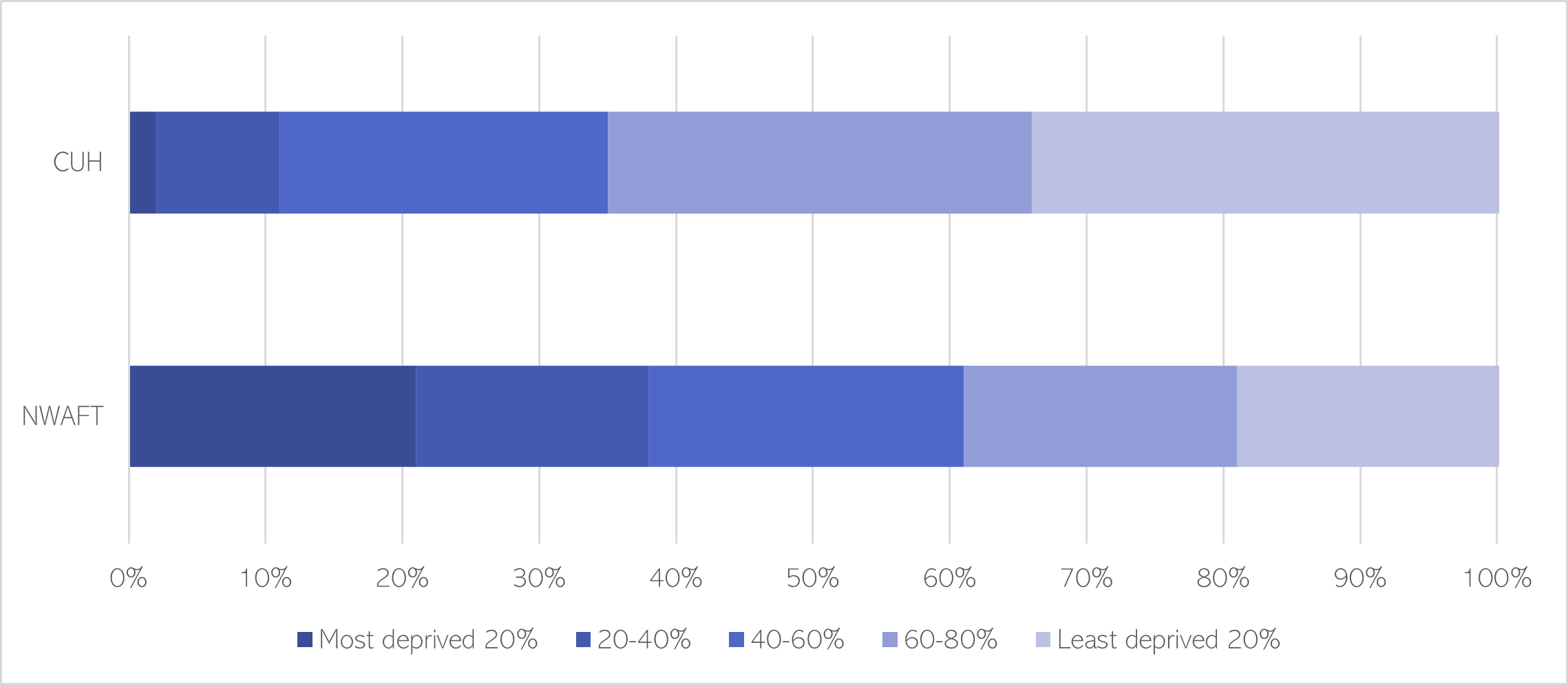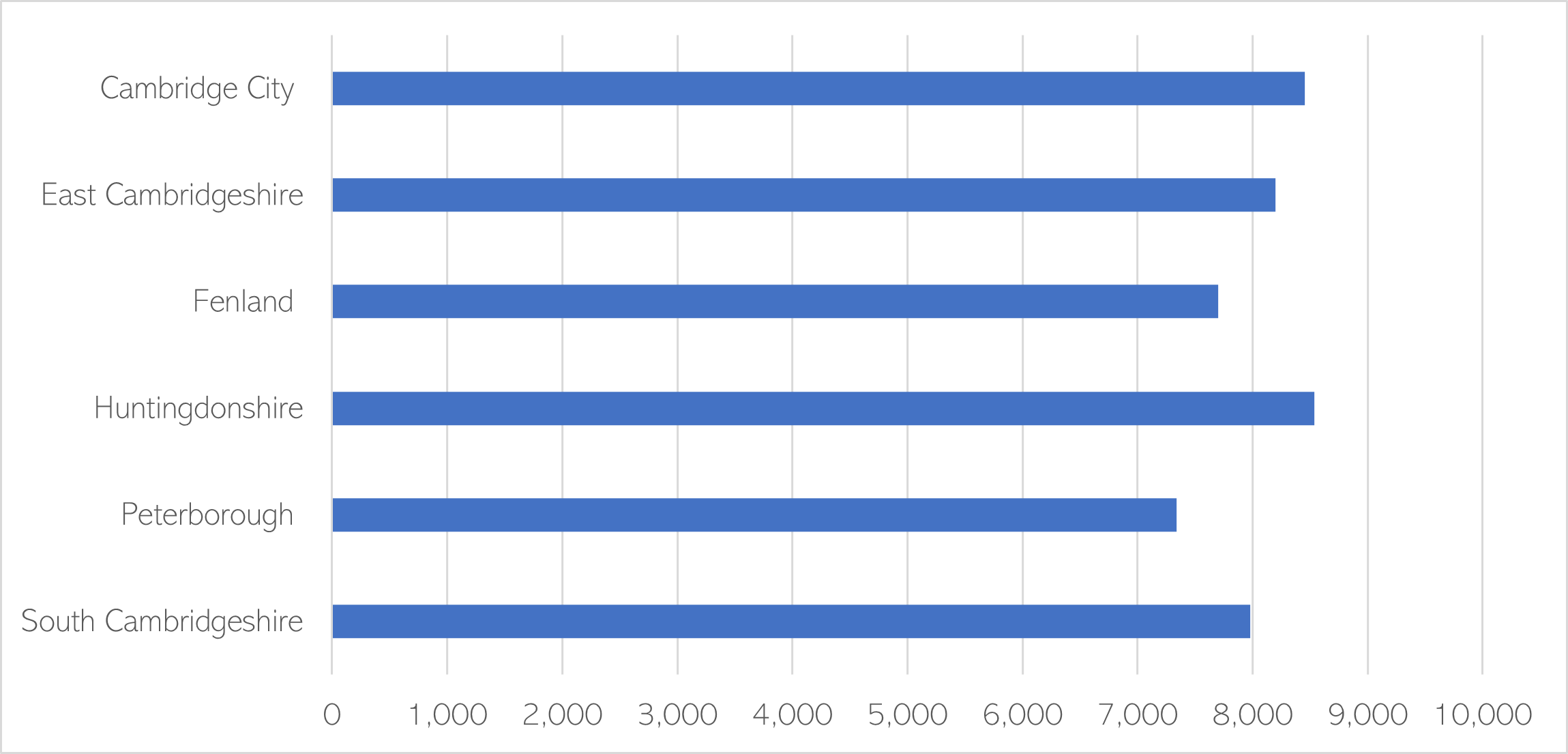Deprivation
- The Marmot review highlights that there is a strong association between the ‘health of mothers and the health of babies’, and that there are ‘equally strong associations between the health of mothers and their socioeconomic circumstances’ (48).
- Women living in more deprived areas are at greater risk of experiencing poor mental health during the perinatal period. The increased risk for women in the most deprived areas, compared to those in the least deprived areas, is greatest for those aged between 35 and 45, who are (49):
- 2.5 times more likely to experience anxiety.
- 2.6 times more likely to experience depression.
- 7.7 times more likely to experience a severe mental illness (SMI).
- Women from the most deprived neighbourhoods are more likely to have pre-existing depression, a SMI or another mental health condition when they become pregnant (50).
Local population
There is substantial variation in levels of deprivation across Cambridgeshire and Peterborough: 21% of mothers who gave birth in North West Anglia NHS Foundation Trust (NWAFT) in 2022 lived in the top 20% most deprived areas nationally, compared to 2% in Cambridge University Hospitals (CUH).
Figure 7: Births by index of multiple deprivation (IMD) of mother at booking at Cambridge University Hospitals (CUH) and North West Anglia NHS Foundation Trust (NWAFT) in December 2022. Data source: National Maternity Dashboard
Access
Women living in more deprived neighbourhoods are less likely to have been seen by a midwife or GP for their routine 6- to 8-week postnatal review (51). They are less likely to be asked about their mental health during pregnancy and the postnatal period, and to be offered treatment and receive support (52).
Maternity exemption certificates allow anyone who is pregnant or has given birth in the past 12 months to access free NHS prescriptions and dental treatment. Applications have to be authorised by a midwife, doctor or health visitor. The uptake of maternity exemption certificates is lower in more deprived areas and reduced significantly during 2020/21 and 2021/22 (53). Locally, uptake across Cambridge has estimated to vary from 73% in Peterborough to 85% in Huntingdonshire.
Figure 8: Active maternity exemption certificates per 10,000 live births by district (2021/22). Data source: NHSBA
Experience
Women living in more deprived areas are less likely to feel that they have been treated respectfully by healthcare professionals, or that they were spoken to in ways they can understand by midwives and doctors (51).
References
48. Marmot M. Health equity in England: The Marmot review 10 years on. The BMJ. 2020;368.
49. Ban L, Gibson JE, West J, Fiaschi L, Oates MR, Tata LJ. Impact of socioeconomic deprivation on maternal perinatal mental illnesses presenting to UK general practice. British Journal of General Practice. 2012;62(603).
50. Lee SI, Azcoaga-Lorenzo A, Agrawal U, Kennedy JI, Fagbamigbe AF, Hope H, et al. Epidemiology of pre-existing multimorbidity in pregnant women in the UK in 2018: a population-based cross-sectional study. BMC Pregnancy Childbirth. 2022;22(1).
51. Lindquist A, Kurinczuk JJ, Redshaw M, Knight M. Experiences, utilisation and outcomes of maternity care in England among women from different socio-economic groups: Findings from the 2010 National Maternity Survey. BJOG. 2015;122(12).
52. Redshaw M, Henderson J. Who is actually asked about their mental health in pregnancy and the postnatal period? Findings from a national survey. BMC Psychiatry. 2016;16(1).
53. NHS. Healthcare Inequalities: Access to NHS prescribing and exemption schemes in England [Internet]. 2023 [cited 2023 May 24]. Available from: https://nhsbsa-data-analytics.shinyapps.io/healthcare-inequalities-nhs-prescribing-and-exemption-schemes/


